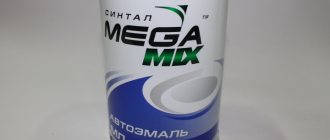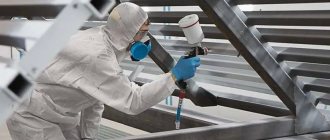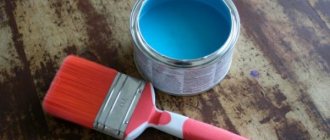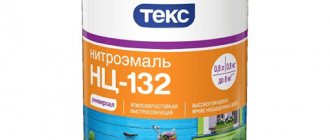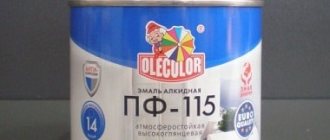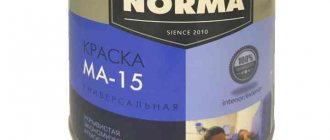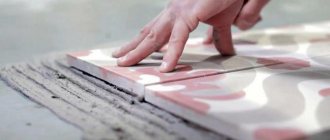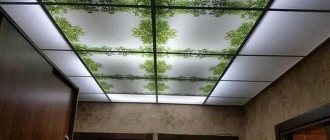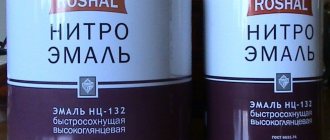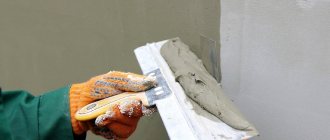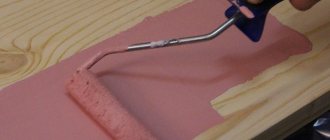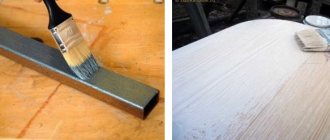Application order
Before painting, you need to carry out preparatory measures.
Surfaces are cleaned of dirt, debris, dust, and oil stains. Existing rust needs to be removed. Metal products are pre-primed using primers such as GF-020-021, FL-03K, GF-032.
You can dilute the dull-colored product with solvent 646 in a 5:1 ratio and use it as a primer. It is also advisable to prime wood, although this is not necessary, as when processing metal.
The base must be completely dry before painting. The paint should be thoroughly mixed, and the thickened film should be removed from above. How to dilute the material if the thickness is exceeded? You can use the same solvent 646.
Application is carried out depending on the type of paint using a brush or spray. After creating the first layer, wait 2.5 hours, then apply another layer. Polishing may only be done after final drying.
Advantages and disadvantages
This enamel is very popular today, as it has many important advantages:
- excellent elasticity, so enamel can be used to paint structures of any geometric shape and relief;
- due to its high moisture resistance, the paint can be used in damp buildings, damp structures, as well as outdoors;
- has a long service life and excellent wear resistance, so the original appearance of the painted product is preserved for several years;
- dried paint is very easy to care for, it can be washed using household chemicals, including abrasives;
- is resistant to ultraviolet rays, so the enamel layer does not fade in the sun and does not crack over time;
- is not afraid of sudden temperature changes, can be used in aggressive environments, as well as in cold and hot climates;
- has a good combination of low price and excellent quality, thanks to which the consumer saves money and gets excellent results;
- A large selection of colors makes it possible to implement any design solutions. After painting, the surface becomes glossy.
Despite these advantages, this enamel has several disadvantages, one of them is the high toxicity of the solution. When working with this mixture, you must follow safety precautions, use a respirator, gloves and goggles. If application is carried out indoors, there must be good ventilation. Another disadvantage is the flammability of the composition, so you should not paint objects near sources of open fire and heating devices, especially those with electric heating elements.
NTs-132 price
You can buy enamel in a price range from 90 to 200 rubles per kilogram; it is most profitable to buy paint in bulk and in large packages, 18 kilogram buckets and 50 kilogram drums. The price practically does not depend on the color. Prices cannot be lower than 80 rubles. The fact is that the components included in this nitro paint are quite expensive; replacing them will lead to the loss of the basic properties of NC enamels. Namely, quickly dry, polish and wash off with solvents 646, 647, 649. Recently, consumers have been complaining about the smell of “NTs-132”, which takes a long time to dissipate, the whole point is that some manufacturers are deceiving consumers under the brand NTs-132 GOST 6631- 74 sell a modified quick-drying PF, this is a completely different paint, with different properties. It costs less than 70 rubles per kilogram. You can distinguish NC paint from PF paint by smell. Real NC smells like solvent 646, the smell of real NC-132 disappears within half an hour.
If, after application and complete drying, solvent 646 is poured onto the coating, real NC will swell, and the modified PF will smear.
Enamel NC 132 Master price
- 0.7 kg – 132 RUR/kg
- 1.7 kg – 124 RUR/kg
- 18 kg – 96 RUR/kg
- 50 kg - 92 rub./kg.
More detailed information can be found in the price lists of our sales departments.
TEST METHODS
3.1. Sampling - according to GOST 9980.2-86.
3.2. Preparing samples for testing
The hardness and gloss of the film are determined on special-purpose glass plates measuring 90×120 mm and 1.2 mm thick according to TU 21-0284461-058-90. The elasticity of the film during bending is determined on plates made of black tin according to GOST 13345-85 with a size of 20×150 mm and a thickness of 0.25 - 0.32 mm.
The strength of the film upon impact is determined on sheet steel plates in accordance with GOST 16523-89, measuring 70×150 mm with a thickness of 0.5 mm.
All other indicators are determined on plates made of black tin or sheet steel measuring 70x150 mm. Plates for coating are prepared in accordance with GOST 8832-76, section. 3.
Conditional viscosity, mass fraction of non-volatile substances and degree of grinding are determined in undiluted enamels.
The tested enamel is diluted with appropriate solvents to a viscosity of 18 - 20 s using a VZ-246 (or VZ-4) type viscometer with a nozzle diameter of 4 mm, filtered through a sieve with a mesh 01 - 02 according to GOST 6613-86 and applied to prepared plates in one layer paint sprayer. The thickness of the dried film of a single-layer coating should be 18 - 23 microns.
To determine color, appearance and gloss, enamel is applied to the plates in two layers. The thickness of the two-layer coating is 35 – 45 microns.
To determine the resistance of the enamel film to the static effects of water and mineral oil, the enamel is applied in two layers over a glypthal or pentaphthalic primer, and the primer is applied to both sides of the plate. The thickness of the coating system should be 45 – 55 microns.
Drying of the second layer of enamel when determining color and appearance and the last layer when determining hiding power is carried out at (20 ± 2) ° C for 3 hours, and for enamel of the first quality quality - for 2 hours.
To determine all other indicators, drying of a single-layer coating and the second layer of a two-layer coating is carried out according to paragraph 8 of the table. 1 to degree 4 or at a temperature of 60 °C for 3 hours, tested according to indicators 3, 8, 9, 10 of table. 1 is carried out without holding the samples after cold drying and 3 hours at a temperature of (20 ± 2) °C after hot drying.
Drying between layers is carried out at a temperature of (20 ± 2) °C for 1 hour.
In case of disagreement in assessing the quality of enamels, dry the coating to determine the indicators according to points 3, 9, 10, 11, 12 of table. 1 is carried out according to point 8 of the table. 1 to degree 4.
(Changed edition, Amendment No. 2, 3, 4).
3.3. The color of the dried enamel film is determined by visual comparison with the color of the corresponding samples (standards) of the “Card Index” color or control color samples in natural or artificial daylight diffused light. The samples to be compared should be in the same plane at a distance of 300 - 500 mm from the observer’s eyes at a viewing angle that excludes surface gloss. In cases of disagreement in the assessment, the determination of color in natural daylight is taken as the final result.
The appearance of the dried enamel film is determined visually in diffuse daylight.
(Changed edition, Amendment No. 3).
3.3a. Conditional viscosity is determined using a viscometer type VZ-246 (or VZ-4) with a nozzle diameter of 4 mm.
(Changed edition, Amendment No. 3).
3.3b. The mass fraction of non-volatile substances is determined according to GOST 17537-72. A sample of the tested enamel weighing 1.5–2 g is placed in a drying cabinet and kept at a temperature of (105 ± 2) °C. The first weighing is carried out after 1.5 hours of exposure in the cabinet, and subsequent weighings are carried out every 30 minutes until constant weight.
It is possible to determine the mass fraction of non-volatile substances under an infrared lamp at a temperature of (105 ± 2) °C. If there is disagreement in the assessment of the mass fraction of non-volatile substances, the final result is determination in an oven.
(Introduced additionally, Amendment No. 2).
3.4. Drying time is determined according to GOST 19007-73.
When determining the drying time to degree 3, minor marks are allowed.
3.5. Determination of the resistance of the enamel film to the static effects of water and industrial oil.
3.5.1. The resistance of the film to the static effects of water and industrial oil is determined according to GOST 9.403-80, section. 2, in this case, distilled water is used in accordance with GOST 6709-72 and industrial oil in accordance with GOST 20799-88. Painted and dried samples are placed in the test solution at 2/3 of the height and the plates are kept in it for the time specified in paragraph 12 of the table. 1. After testing, the plates with the film are kept in air for 2 hours at a temperature of (20 ± 2) °C and the appearance of the film is examined.
Slight lightening and dulling when tested in water and very slight darkening when tested in oil is acceptable.
(Changed edition, Amendment No. 1, 2, 3).
Compound
NTs-132 enamel is produced in accordance with GOST 6631-74. This paint and varnish material is often called nitroenamel, since it contains a nitrocellulose substance. In addition to it, the composition contains the following components:
- alkyd resins;
- driers, plasticizers;
- varnish colloxylin;
- various pigments;
- certain fillers.
This mixture is produced in 2 similar versions - NTs-132 K and NTs-132 P. These solutions are almost identical in composition, but they have different conditional viscosity and different volumes of dry residue. The mixture marked “K” is applied with a brush, and the paint marked “P” is applied by spraying from a spray bottle. This solution is packaged in metal cans of 0.8 and 1.5 kilograms, and you can also order enamel in large industrial containers.
Details and details
Varieties
Technical parameters and types of enamel NTs-132 will be regulated according to GOST 6631-74. There are a couple of types of paints and varnishes:
- NTs-132 “K” is designed to be applied with a brush and has a certain degree of thickness, but it can be diluted with a solvent to a more liquid state.
- NTs-132 “P” is a liquid form that is perfect for spraying with a spray bottle.
Now let’s take a closer look at the technical specifications:
- The air temperature in the external environment for using paint and varnish should be from -12 to +60 degrees.
- A couple of hours after application to the surface treated with such varnish, you can acquire a slight stickiness. Full use is possible only 24 hours after staining.
- A layer of film that forms after hardening, which is characterized by excellent smoothness, the absence of spots, streaks, bumps and depressions.
- The hardness index is not less than 0.15 c.u. It will be determined by a special pendulum device TML.
- The U-1 device makes it possible to measure the impact strength of a layer - not less than 50 cu.
- The gloss of the product will range from 40 to 55%.
- The proportion of volatile substances can be determined by the color of the liquid. For black enamels it will be the lowest (from 22 to 28%), and in other shades it is slightly more than 29% of volatile compositions.
- The service life when kept in a sealed package without violating storage conditions is set at one year.
They also produce enamel in most convenient formats, cans starting from 0.7 kg, as well as 1 and 1.7 kg, and for large barrels it is 17 and 25 kg, sometimes containers are larger.
Colors and shades
In addition, the color scheme is regulated by GOST. The choice of shades is quite large and makes it possible to choose the required color for each type of finish. Light colors include plain white, two types of cream and light gray, as well as light beige. The dark range includes dark blue-green, tobacco, taupe, charcoal, charcoal, khaki and black. If you want a brighter finish, shades such as red, brown, orange-brown and golden brown are suitable options. The colors of the natural type are represented by calm green-beige light shades, pistachio, light grayish green, pale green and grayish blue. If you require another shade, we can also produce it individually according to the RAL catalogue.
Consumption of funds
Enamels are available for sale in ready-made liquid form for use. After opening the can, you will immediately begin finishing work using a sprayer, rollers and brushes. If there is a need to dilute the product, this should be done using solvents.
For enamel type 132 "K" you should use composition 649, and for 132 "P" version 646 according to GOST 18188. In any case, the composition in a newly opened jar should be immediately stirred in order to give it a uniform consistency. The time to achieve dryness and hardness is about a couple of hours at a temperature of +20 degrees. If the thermometer readings in the room/outside differ, then the final result may be obtained in a different time frame.
It is customary to apply two or more layers of NC-132 enamel, the technical characteristics of which are such that optimal hiding power is achieved with just two layers. Consumption is determined precisely by this characteristic. This indicator will indicate how many grams of the composition need to be applied per square meter. The color of the composition will most influence the consumption. Dark shades are black, dark blue-green requires 0.03 kg per square, and light shades are white and cream approximately 0.1 kg per square.
Please note that to reduce enamel consumption, more attention should be paid to surface preparation before painting. Metal bases should be cleaned of corrosion, rust marks and dirt.
It is better to thoroughly dry and sand surfaces for wood materials for improved adhesion. To reduce the absorption of natural material, it is better to use a primer or a thin layer of highly diluted enamel of a similar type. Primer compositions are suitable, or more precisely, AK-070, GF-021, VL-02 and FL-03K. If there are grease stains on the surface, they must be treated with special compounds. If the base was covered with oil paint, it should be removed without a trace in advance.
Application area
Although enamel No. 132 is a toxic and fire-hazardous material, due to its protective and elastic properties it has gained incredible use. Wood products and structures located in harsh climates and high humidity will perfectly preserve their original appearance. Metal surfaces and concrete bases will be reliably protected from corrosion. This is used both for domestic conditions and for processing materials for industrial production. For household use, due to the excellent decorative properties of the paint and varnish material, it can be used for painting furniture, decor and walls. Due to the low consumption, building facades and fences made of metal will benefit from treating the surface with enamel. But the harmful substances that are released when working with nitro enamel have forced certain countries around the world to limit the use of such a product, as well as completely ban it.
Precautionary measures
In view of the above characteristics and toxicity, some recommendations should be followed when using enamels. The materials should be stored in a specially designated area away from flammable materials and direct sunlight. When applying the composition, rubber gloves and respiratory masks should be used to ensure that vapors enter the lungs. Protection must also be provided for the eyes, in the form of special glasses. The use of special clothing is also required. It is better to carry out work in a place with the possibility of ventilation, and painting should be carried out in the absence of open fire. At the end of the work, you should wash your hands and face with soapy water.
Instructions for use of enamel NTs-132
Nitro enamels dry quickly, which must be taken into account when applying with a spray gun. At the same time, the paint sprayer allows you to obtain a high-quality surface when painting, but when working with another tool, drips are possible.
The declared consumption of nitro enamel is 100-120 g/m2.
What is the sequence of work with NTs-132 paint when applied to a metal surface?
|
What is the sequence of work with NTs-132 paint when applied to a wooden surface?
|
Features of application technology
Nitroenamel is a toxic compound. She keeps the fire burning. Therefore, painting is carried out in a ventilated area, fire safety precautions are observed, and personal protective equipment (respirator, gloves) is worn.
- Using special solvents and washes, the old layer of enamel is removed from the surface. Rust and dirt are removed from metal;
- the dried metal surface is primed: VL (VL-023 primer for metal 40 kg + 8 kg acid thinner – 200 rubles); FL-03K (138 rubles per kg); GF-021 (86 rubles per kg); PF-020 (100 rubles per kg); GF-032GS (105 rubles per kg).
Enamel, diluted in a 5:1 ratio with a solvent, is used as a primer: No. 646 for grade NTs-132P and No. 649 for grade “K.”
- The surface of ferrous metals is not primed before painting.
- The jar is opened, the mass is mixed, the film is removed, and the viscosity of the composition is established. Working viscosity according to VZ-4: for NTs-132K 30-60 s, diluted with solvent 649; for marking “P” 18-20 s, solvent 646 is used.
- A two-layer enamel coating is applied. The second time the product is coated with enamel after 2-3 hours.
- After 24 hours, the dried enamel can be polished so that the layer acquires a glossy shine.
Application rules
Depending on the type of enamel chosen, a spray bottle or brush is used. Apply the mixture with smooth, leisurely movements. After applying the first layer, it is important to wait about 2-3 hours, after which it is advisable to apply another layer. When the second layer is completely dry, you can polish the surface.
Since this enamel contains organic solvents, it is flammable, so it should not be applied near open flames or sparks. Paint fumes are toxic, therefore, if painting is done in a room, it must be ventilated both during the work and for several hours after painting is completed. You should work with gloves and goggles to prevent the mixture from getting into your eyes and skin. After finishing dyeing, wash your face and hands thoroughly.
Anti-corrosion protection technologies
Nobody often wants to paint metal structures, so it is better to immediately create such protection that will preserve the metal for at least 7 years. To do this, you need to follow several steps:
- rust converter treatment;
- application of anti-corrosion primer;
- application of a finishing coating that has the required protective and decorative properties.
However, despite the instructions from manufacturers of protective anti-corrosion agents, few people carry out all the steps in everyday life. Usually metal fences, gates, pipes are simply painted, but such “protection” will ensure the safety of the metal for a maximum of a couple of years.
We can agree that three stages are really too much for such an operation as painting, so manufacturers tried to create a more technological “3 in 1” composition that simultaneously prepares, primes and paints the surface. Such paints contain a rust converter, anti-corrosion primer and wear-resistant enamel. Their effect is much superior to conventional paints, but they also save time.
Application of paint and varnish coating
Today there are two varieties of this enamel, which differ in the method of application. The coating marked NTs-132K is applied to the surface using a regular brush, and for NTs-132P compositions the spraying method is used.
Before you begin painting, the surface should be cleaned of dust, dirt, rust and other debris. If metal products are subjected to processing, they are pre-primed. In the case of wood, this work may not be necessary.
NTs-132 enamel itself (gray, white or other soft colors), diluted with a solvent in a ratio of 5:1, can be used as a primer. After the prepared surface has completely dried, you can begin painting it.
The mixture is mixed well, the thick top film is removed and applied using any chosen method (depending on the type of enamel). After applying the first layer, you should wait 2-2.5 hours and begin re-processing the surface. When the protective coating is completely dry, it can be polished.
Color solutions for enamel NTs-132P
The color range is created in accordance with GOST. There is a large selection of colors: blue, black, white, yellow, grey, blue, green, red, orange. And a number of different tint options.
If a color is needed that is not presented in the palette, the manufacturer can produce it according to the Pantone catalog and others.
There is a large selection of colors.
Enamel NTs-132 “KraskaVo” light gray
Enamel NTs-132 "KraskaVo" light gray is a universal paint and varnish material intended for painting metal, wood, and concrete surfaces. Surface painting using NTs-132 can be done both indoors and outdoors, the main scope of application is construction and repair. The enamel is based on colloxylin and alkyd resin in the presence of plasticizers, pigments, and special additives. Enamel NTs-132 “K” is intended for application with a brush, enamel NTs-132 “P” – by spraying.
Advantages of Enamel NTs-132:
- excellent protective and decorative properties;
- durable, elastic coating;
- gives a glossy film;
- weather resistance from -30oC to 60oC;
- water resistance;
- light fastness;
- wear resistance;
- weather resistance;
- resistance to mechanical damage;
- resistance to household chemicals;
- efficiency
- Available in various color shades.
Application
Before working with light gray enamel, you must first clean and prime the surface. Application of enamel is possible only at positive temperatures. Before application, the enamel is mixed and diluted with solvent 646. Apply by brush, roller, or spray method. Drying time – 2 hours at an average temperature of 20oC. Consumption per layer – from 50 to 150 g/m2, two-layer application is recommended. Warranty period – 1 year from the date of manufacture in unopened containers
When working with the product, precautions must be taken
NTs-132 is produced in a container convenient for the consumer - 18 kg. The characteristics of the enamel correspond to the parameters of GOST 6631-74. For such packaging, the product has a low price, which consumers like. The lid opens along the perimeter, the enamel is easy to mix, pour into smaller containers, and move. NTs-132 from KraskaVo is the best option for painting small areas.
| Characteristic | Index | Characteristic | Index |
| Brand | LLC NPK "KraskaVo" | Consumption | 5-10 m2/kg |
| Gross weight | 18 kg | Recommended number of layers | 1-2 |
| Type | Enamel | Drying time at 20°C (+/- 2°C) | 2 hours |
| Brand | NTs-132 | Drying time at 20°C (+/- 2°C) | 24 hours |
| The basis | Nitrocellulose | Density | 1 kg/l |
| Color | Light gray | Application temperature | – 5 — +40оС |
| Type of application | For indoor and outdoor use | Dry residue | 18-30 % |
| Room | For living room, bedroom, kitchen, corridor, staircases | Best before date | 12 months |
| Series | Station wagon | Conditional viscosity according to a VZ-246 viscometer with a nozzle Ø of 4 mm at t (20.0±0.5)°C | 60-100 s |
| Objects of application | For walls, fences, doors, windows | Film elasticity when bending, mm, no more | 1 |
| Base material | Wood, metal | Film hardness according to a pendulum device of the TML type (pendulum A), rel. units | 0,15 |
| Tools | Brush, roller, spray | Film gloss, %, not less | not <56 |
| Gloss level | Glossy | Covering power of the dried film | 60-100 g/m2 |
| Diluent | Solvent 646 | Components | One-component |
| Consumption | 50-150 g/m2 | Country of Origin | Russia |
Color shades
GOST also determines the color shades of enamel, and the variety of available color options is very large, so everyone can easily choose exactly the color shade that they need.
Light colors are produced in white, grey, cream beige tones and shades.
Dark ones are made in a wide variety of variations, for example, in tobacco and in many other color shades.
Among the natural color shades there are options for greenish or yellowish shades, bluish or pistachio tones.
Among other things, it is possible to create enamel in individual color shades according to the catalogue.
Types and technical characteristics
On sale you can find several types of coatings made with cellulose ethers. The most popular are NTs-132 and NTs-25. These enamels are available in several dozen colors. Used for painting wooden and metal surfaces, mainly indoors. Dry in 1-3 hours at room temperature. To dilute them, solvents 645, 646 and others are used.
After drying, they form a thin film on the surface. Apply in several layers (from 2 to 5 and 10). Manufacturers even produce nitro enamels NTs-132 separately for application with a paint sprayer (marked with the letter “P”) and with a brush (with the letter “K”).
The following nitro paints are more resistant to moisture and atmospheric factors: NTs-11, NTs-5123. Enamels are used for painting metal and wooden surfaces used outdoors or indoors. After applying the nitro paint, the coating dries in 1-2 hours. Reducing viscosity is achieved using solvents 646, 647 and others. Nitroenamel is applied to the surface in 1-5 or more layers. After painting, the surface does not change its appearance for 3 years and can be used at temperatures from -40 to +60 degrees Celsius.
The main types of nitro paints sold in construction supermarkets:
- aerosol nitroenamel (in cans);
- nitrocellulose enamel (in cans).
All nitro paints are one-component and completely ready for use. Any nitro enamel contains solvents that evaporate as the paint dries. It is recommended to work with this type of enamels at positive temperatures and air humidity of no more than 70 percent.
What are the technical type parameters?
Among the main technical characteristics, the following can be noted:
- The enamel can be used at air temperatures ranging from minus 12 to plus 60 degrees Celsius;
- Already two hours after its application, the enamel becomes slightly sticky, and the complete drying of the enamel, after which the surfaces can be used with it, takes about a day;
- The film layer that is formed by this enamel after it dries is distinguished by a high level of smoothness, and does not form any various bumps, all kinds of dimples or spots;
- The characteristics of the enamel hardness level are approximately 0.15 cu, the process of establishing this parameter is carried out through the use of a special device;
- Thanks to the special one, it also becomes possible to measure the degree of impact resistance of the enamel layer, which is approximately 50 cu;
- The gloss level of the enamel surface is approximately 40-55 percent;
- The degree of presence of volatile substances in the composition can be determined by the color shade of the liquid; in black enamels their presence is the lowest - around 22-28 percent, in other color varieties it is around 29 percent;
- If the seal of the packaging of this enamel is not compromised in any way, then the shelf life of such enamel, provided it is properly stored, is one year.
Today, these enamels are produced in a wide variety of formats in cans - 0.7 or 1 kilogram, 1.7 kilogram. Large barrels of this enamel are also being produced, weighing 17 and 25 kilograms; such options are used for industrial purposes.
Features of work and technology of applying nitro enamels
The main questions when working with nitro enamels are whether it is possible to paint with nitro paint over oil paint and whether it is possible to paint with oil paint over previously applied nitro enamels.
NC paints cannot be applied to oil or alkyd paints - the surface may swell, after which the nitro enamel will simply curl up and peel off.
In addition, nitro paint is a rather fragile coating that is easily scratched and damaged by impacts.
High quality coating is obtained only if the preparatory work is carried out correctly.
The technology for applying nitro-enamel compositions is as follows:
- Dirt, rust and dust are removed from the surface;
- It is recommended to prime both wood and metal;
- the enamel is thoroughly mixed, the film is removed, and a solvent is added if necessary;
- after the primer has dried, painting is performed;
- subsequent layers of nitro paint can be applied after 40 minutes, but it is better to wait 2-3 hours;
- Once dry, the enamel can be polished to add gloss and additional shine.
Despite the emergence of new paint and varnish compositions and high toxicity, nitro paints are not inferior to their positions when performing repair work.
What are the precautions for use?
Due to the fact that this enamel is somewhat toxic, its use must be accompanied by compliance with safety measures. The storage process should be carried out in rooms where there is no exposure to sunlight, away from fire hazardous, flammable materials.
When carrying out the application process, it is better to use gloves and respirators, and special glasses that will protect your eyes. Application work should be carried out in special clothing. During such work, it is strongly recommended to do ventilation; there should be no open sources of fire during work.
Today, this enamel enjoys well-deserved trust from numerous users, and this is not at all surprising, given its many advantages and advantages.
Distinctive features of the composition
Nitro paints are made on the basis of nitrocellulose, modified alkyd resins and other additives. Such paints and varnishes are marked with the letters “NC”. Manufacturers of paints and varnishes produce various nitrocellulose paints, enamels, and varnishes. The main feature of this type of product is that after painting the coating dries quickly.
Advantages and disadvantages
sold completely ready for painting;
dry quickly (in a few minutes) due to natural evaporation of the solvent;
form a hard, durable coating that is resistant to moisture, ultraviolet radiation, mechanical damage, and abrasion;
protect metal from corrosion;
Available in various colors;
come with a glossy or matte sheen;
after drying, the coating acquires a mirror shine when sanded and polished;
nitro enamels can be applied to wood, metal, MDF, chipboard, concrete, plaster;
coating resistant to wet cleaning and household chemicals;
all enamels are diluted with a certain type of solvent;
are characterized by low consumption (30-120 grams per 1 square meter) and reasonable price;
applied to the surface using a brush or spray gun;
the painted surface retains its appearance for 2 years or more.
have a toxic composition;
the paint itself is fire hazardous;
when dry, they release toxic fumes into the air;
have low adhesion to metal (require preliminary priming);
when applied, they create a thin film and require painting in several layers (up to ten);
Do not spray over oil, alkyd or acrylic coatings;
have low resistance to acids and chemicals;
not recommended for outdoor use (relatively low resistance to adverse weather conditions);
with frequent contact of the painted surface with water, white spots form;
When drying in a room with high humidity, whitish spots appear (in some cases, slowly evaporating solvents are required).
Special qualities of the composition
A film is formed that is resistant to friction, scratching, and mechanical stress.
Important: the film coating is highly elastic, which allows you to paint parts and products with complex configurations.
The answer to the question why the product remains in demand will be clear if we consider the qualities of the NTs-132 composition inherent in nitro enamel:
- High resistance on the film surface to water, household chemicals, and frequent wet cleaning with detergents. The composition is used in rooms with high humidity.
- An important advantage of the NTs-132 product is that the painted surface will not be damaged by grinding and polishing. On the contrary, the decorative layer acquires increased shine.
- Enamel is an economical material; consumption is low. She is easy to work with.
- Protective and decorative coating with a long service life and high drying speed.
- The coating has anti-corrosion properties.
- The brightness of the color of the enamel layer remains for a long time under the influence of direct sunlight.
The paint is available in an assortment of colors with light and dark shades. If necessary, the composition is tinted according to the RAL and Pantone catalogs.
Consumption
The enamel is sold ready-made and does not require additional dilution. Application can be done using a spray gun, roller and brush. Compared to a brush, working with a roller is much faster and easier, but it should be borne in mind that its use significantly increases the consumption of enamel. It is recommended to paint surfaces with paints and varnishes in two or three layers.
In this case, paint consumption directly depends on the hiding power of the material. The higher this value, the less paint will be needed for painting.
The preparation of the working surface has a great influence on the consumption of enamel. If a metal base is to be painted, it must be thoroughly cleaned of rust, scale and dirt. Then the surface must be degreased and treated with a primer. Wooden bases also require preliminary preparation, which consists of drying and then sanding the surface. Then you should prime the wood and wait until the auxiliary layer dries completely.
Primer compositions AK-070, VL-02 and GF-021 have proven themselves well.
Instead of a ready-made primer, you can use a solution of light enamel NTs-132 and solvent, taken in a ratio of 5: 1. It must be remembered that wooden objects, due to their high porosity, have good absorbency and need double or triple painting. This property of wood should be taken into account when calculating the required number of cans and purchase material with a small margin.
What is the cost?
The enamel is sold quite liquid, and therefore, having carried out the process of opening the can of enamel, you can immediately begin painting work either with a spray, or with a brush, or with a roller. When the dilution process is to be carried out, solvents should be used.
To carry out the process of diluting the enamel, which is produced with the designation “K”, you should use a solvent numbered 649, for type “P” composition numbered 646, according to GOST number 18188. Again, the newly opened enamel must be thoroughly mixed so that the enamel has a homogeneous composition. Two hours after application, the surface becomes drier and harder, the temperature should be 20 degrees Celsius. Drying times may vary in other temperatures.
In most cases, the process of applying two layers of enamel or more is carried out in order to obtain a greater degree of coverage. The covering characteristics of the enamel determine how many grams should be applied per square meter. The degree of enamel consumption is mostly determined by color, for example, darker shades, such as black or dark blue-green, will require approximately 30 grams of enamel per square meter, but lighter shades, for example, white or beige, will require about 100 grams per square meter of surface.
To reduce the level of consumption of this enamel, it is necessary to carry out the process of preparing the surface to be painted in a high-quality manner. Corrosion and contamination should be thoroughly removed from metal surfaces. It is recommended to thoroughly dry and clean wooden surfaces, and to reduce absorbency, apply a primer or a thin layer of pre-diluted same enamel. Use primers like AK-070 or GF-021, FL-03K or VL-02.
Peculiarities
NTs-132 enamel has been produced since the 70s of the last century, and it is difficult to believe that paint and varnish compositions have not yet been invented that would surpass it in their characteristics. Unlike paints, enamels form, after complete hardening, a smooth, uniform layer that protects the surface from various influences.
Initially, the main difference between enamel and paint was the type of thinning liquid. For enamel coatings, volatile compositions on an organic basis were used. In the case of paint, it could be drying oils or ordinary water. Over time, more and more water-dispersion enamels and acrylic-based coatings began to appear.
The letters NTs indicate that this enamel belongs to the group of nitrocellulose, that is, paints and varnishes made on the basis of nitrocellulose. This is a white fibrous structure, loose in appearance, reminiscent of ordinary cellulose and obtained from it by treatment with nitrogen.
The composition of NC-132 includes volatile and non-volatile parts. The first group includes alkyd resins (No188 according to the classification of resins), colloxylin-nitrocellulose with a nitrogen content of 10.7-12.2%, plasticizing additives and pigmenting particles. The non-volatile group differs for different types of enamels. It includes either 40% toluene, butyl or ethyl alcohol, about 15% active high-boiling solvents and slightly less low-boiling ones. In the second case, xylene is added instead of toluene, and solvents reach 30%. To improve decorative properties and smooth surface distribution, an anti-flotation additive and an additive to increase fire resistance can be added.
Manufacturers pay attention to the exceptional resistance of NC-132 enamel to various influences. In addition, the following positive qualities are noted:
In addition, the following positive qualities are noted:
- high strength and wear resistance;
- elastic structure suitable for use of any shape and surface shape;
- water resistance allows the enamel to be used in buildings with high humidity and outdoors;
- ease of care for surfaces coated with paints and varnishes - can be washed with any household products;
- the enamel layer can be ground and polished to give a glossy shine, which will further affect the decorative appearance of the products;
- the coating does not fade in the sun and is not susceptible to ultraviolet radiation;
- withstands strong temperature fluctuations;
- the material is economical and has a low price;
- long service life. When treating the surface with enamel in two layers in moderate climatic conditions, the coating can retain its decorative and quality features for up to two years.
Application area
NTs-132 is a universal enamel for covering any surface. Among other enamels, varnishes and paints, it takes its rightful place because it has a wide range of applications. Suitable for external and internal work. The paint is very popular due to its variety of colors, is durable, dries quickly, and is resistant to temperature changes. Its main feature is its special elasticity, which allows it to be used on surfaces of any complexity with any curvature. The coating obtained by painting is so wear-resistant that it can be polished to give the coating a beautiful gloss.
Examples of using
Since the coating formed by enamel is resistant to detergents and water, enamel is successfully used in rooms with any level of humidity. Moreover, it has impact resistance and resistance to mechanical stress, which makes it indispensable for use in industry and construction. It is convenient to use enamel for household purposes - due to the wide range of colors and fast drying, you can paint a bench in the yard, a fence in the country, gates, pillars, pipes and, without waiting a long time, use them without fear of ruining the coating.
